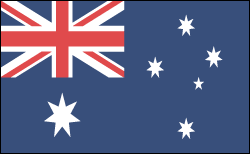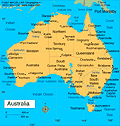Australia
Sovereign: Queen Elizabeth II (1952)
Governor-General: Quentin Bryce (2008)
Prime Minister: Julia Gillard (2010)
Land area: 2,941,283 sq mi (7,617,931 sq km); total area:2,967,893 sq mi (7,686,850 sq km)
Population (2011 est.): 21,766,711 (growth rate: 1.148%); birth rate: 12.33/1000; infant mortality rate: 4.61/1000; life expectancy: 81.81
Capital (2009 est.): Canberra, 384,000
Largest cities: Sydney 4.429 million; Melbourne 3.853 million; Brisbane 1.97 million; Perth 1.599 million (2009)
Monetary unit: Australian dollar
Languages: English 78.5%, Chinese 2.5%, Italian 1.6%, Greek 1.3%, Arabic 1.2%, Vietnamese 1%, other 8.2%, unspecified 5.7% (2006 Census)
Ethnicity/race: Caucasian 92%, Asian 7%, aboriginal and other 1%
Religions: Protestant 27.4% (Anglican 18.7%, Uniting Church 5.7%, Presbyterian and Reformed 3%), Catholic 25.8%, Eastern Orthodox 2.7%, other Christian 7.9%, Buddhist 2.1%, Muslim 1.7%, other 2.4%, unspecified 11.3%, none 18.7% (2006 Census)
National Holiday: Australia Day, January 26
Literacy rate: 99% (2003 est.)
Economic summary: GDP/PPP$917.7 billion (2011 est.); per capita $40,800. Real growth rate: 1.8%.Inflation: 3.4%. Unemployment: 5%.Arable land: 6.15%. Agriculture:wheat, barley, sugarcane, fruits; cattle, sheep, poultry. Labor force: 12.02 million; agriculture 3.6%, industry 21.1%, services 70.4% (2009 est.).Industries: mining, industrial and transportation equipment, food processing, chemicals, steel. Natural resources: bauxite, coal, iron ore, copper, tin, gold, silver, uranium, nickel, tungsten, mineral sands, lead, zinc, diamonds, natural gas, petroleum. Exports: $266 billion (2011 est.): coal, gold, meat, wool, alumina, iron ore, wheat, machinery and transport equipment. Imports: $236.3 billion (2011 est.): machinery and transport equipment, computers and office machines, telecommunication equipment and parts; crude oil and petroleum products. Major trading partners: China, US, Japan, Thailand, Singapore, South Korea, India, Germany, Malaysia (2010).
Member of Commonwealth of Nations
Communications: Telephones: main lines in use: 8.66 million (2010); mobile cellular: 22.5 million (2010). Broadcast media: the Australian Broadcasting Corporation (ABC) runs multiple national and local radio networks and TV stations, as well as Australia Network, a TV service that broadcasts throughout the Asia-Pacific region and is the main public broadcaster; Special Broadcasting Service (SBS), a second large public broadcaster, operates radio and TV networks broadcasting in multiple languages; several large national commercial TV networks, a large number of local commercial TV stations, and hundreds of commercial radio stations are accessible; cable and satellite systems are available (2008). Internet hosts: 13.361 million (2010). Internet users: 15.81 million (2009).
Transportation: Railways: total: 38,445 km. Highways: total: 818,356 km (2008). Waterways: 2,000 km (mainly used for recreation on Murray and Murray-Darling river systems) (2006). Ports and terminals:Brisbane, Cairns, Dampier, Darwin, Fremantle, Gladstone, Geelong, Hay Point, Hobart, Jervis Bay, Melbourne, Newcastle, Port Adelaide, Port Dalrymple, Port Hedland, Port Kembla, Port Lincoln, Port Walcott, Sydney.Airports: 465 (2010).
International disputes: In 2007, Australia and Timor-Leste signed agreed to a 50-year development zone and revenue sharing arrangement and deferred a maritime boundary; Australia asserts land and maritime claims to Antarctica; Australia's 2004 submission to Commission on the Limits of the Continental Shelf (CLCS) extends its continental margins over 3.37 million square kilometers, expanding its seabed roughly 30 percent beyond its claimed exclusive economic zone; all borders between Indonesia and Australia have been agreed upon bilaterally, but a 1997 treaty that would settle the last of their maritime and Exclusive Economic Zone (EEZ) boundary has yet to be ratified by Indonesia's legislature; Indonesian groups challenge Australia's claim to Ashmore Reef; Australia has closed parts of the Ashmore and Cartier reserve to Indonesian traditional fishing
Major sources and definitions |
 |
Geography
The continent of Australia, with the island state of Tasmania, is approximately equal in area to the United States (excluding Alaska and Hawaii). Mountain ranges run from north to south along the east coast, reaching their highest point in Mount Kosciusko (7,308 ft; 2,228 m). The western half of the continent is occupied by a desert plateau that rises into barren, rolling hills near the west coast. The Great Barrier Reef, extending about 1,245 mi (2,000 km), lies along the northeast coast. The island of Tasmania (26,178 sq mi; 67,800 sq km) is off the southeast coast.
Government
Democracy. Symbolic executive power is vested in the British monarch, who is represented throughout Australia by the governor-general.
History
The first inhabitants of Australia were the Aborigines, who migrated there at least 40,000 years ago from Southeast Asia. There may have been between a half million to a full million Aborigines at the time of European settlement; today about 350,000 live in Australia.
Dutch, Portuguese, and Spanish ships sighted Australia in the 17th century; the Dutch landed at the Gulf of Carpentaria in 1606. In 1616 the territory became known as New Holland. The British arrived in 1688, but it was not until Captain James Cook's voyage in 1770 that Great Britain claimed possession of the vast island, calling it New South Wales. A British penal colony was set up at Port Jackson (what is now Sydney) in 1788, and about 161,000 transported English convicts were settled there until the system was suspended in 1839.
Free settlers and former prisoners established six colonies: New South Wales (1786), Tasmania (then Van Diemen's Land) (1825), Western Australia (1829), South Australia (1834), Victoria (1851), and Queensland (1859). Various gold rushes attracted settlers, as did the mining of other minerals. Sheep farming and grain soon grew into important economic enterprises. The six colonies became states and in 1901 federated into the Commonwealth of Australia with a constitution that incorporated British parliamentary and U.S. federal traditions. Australia became known for its liberal legislation: free compulsory education, protected trade unionism with industrial conciliation and arbitration, the secret ballot, women's suffrage, maternity allowances, and sickness and old-age pensions.
From the World Wars to the End of the Millennium
Australia fought alongside Britain in World War I, notably with the Australia and New Zealand Army Corps (ANZAC) in the Dardanelles campaign (1915). Participation in World War II helped Australia forge closer ties to the United States. Parliamentary power in the second half of the 20th century shifted between three political parties: the Australian Labour Party, the Liberal Party, and the National Party. Australia relaxed its discriminatory immigration laws in the 1960s and 1970s, which favored Northern Europeans. Thereafter, about 40% of its immigrants came from Asia, diversifying a population that was predominantly of English and Irish heritage. An Aboriginal movement that grew in the 1960s gained full citizenship and improved education for the country's poorest socioeconomic group.
In March 1996, the opposition Liberal Party–National Party coalition easily won the national elections, removing the Labour Party after 13 years in power. Pressure from the new, conservative One Nation Party threatened to reduce the gains made by Aborigines and to limit immigration.
In Sept. 1999, Australia led the international peacekeeping force sent to restore order in East Timor after pro-Indonesian militias began massacring civilians to thwart East Timor's referendum on independence.
Changes in Immigration Policy
John Howard won a third term in Nov. 2001, primarily as the result of his tough policy against illegal immigration. This policy has also brought him considerable criticism: refugees attempting to enter Australia—most of them from Afghanistan, Iran, and Iraq and numbering about 5,000 annually—have been imprisoned in bleak detention camps and subjected to a lengthy immigration process. Asylum-seekers have staged riots and hunger strikes. Howard has also dealt with refugees through the “Pacific solution,” which reroutes boat people from Australian shores to camps in Papua New Guinea and Nauru. In 2004, however, the government began easing its policies on immigration.
Australia on the International Stage as Peacekeeper
Prime Minister Howard sent 2,000 Australian troops to fight alongside American and British troops in the 2003 Iraq war, despite strong opposition among Australians.
In July 2003, Australia successfully restored order to the Solomon Islands, which had descended into lawlessness during a brutal civil war.
Australian citizens have been the victims of two significant terrorist attacks in recent years: the 2002 Bali, Indonesia, bombings by a group with ties to al-Qaeda in which 202 died, many of whom were Australian, and the 2004 attack on the Australian embassy in Indonesia, which killed ten.
In Oct. 2004, Howard won a fourth term as prime minister. When rival security forces in East Timor began fighting each other in 2006, Australia sent 3,000 peacekeeping troops to stem the violence. Howard was defeated by the Labor Party's Kevin Rudd in elections in Nov. 2007. Rudd campaigned on a platform for change, and promised to focus on the environment, education, and healthcare. Observers predicted Rudd would maintain a close relationship with the United States. The military began withdrawing Australia’s 550 troops from Iraq in June 2008, following through on a promise made by Rudd.
The worst wildfires in Australian history killed at least 181 people in the state of Victoria, injured more than a hundred, and destroyed more than 900 houses in Feb. 2009. At least one of the fires was determined to be the work of arsonists. Australian officials were criticized for failing to evacuate those in danger. A government inquiry was requested to research the state's response to the fires.
Australia Elects Its First Female Prime Minister
Rudd's popularity plummeted in May 2010, largely because he shelved his environmental policy that centered on an emissions-trading system. In June, the Labor Party ousted him as its leader and elected his deputy, Julia Gillard. She became Australia's first female prime minister in June and promptly called for elections, which were held in August. They resulted in a hung parliament, with neither the incumbent Labor Party nor the conservative Liberal-National coalition, led by Tony Abbott, taking a majority of seats. It is the country's first hung parliament in 70 years. After several weeks of attempting to woo members of parliament to her side, Gillard succeeded in early September, when two independents backed her. It was enough to give her the slimmest majority: 76 out of 150 seats.
Worst Flooding in Decades
In Jan. 2011, the worst flooding for decades in Queensland cut off many cities and towns. The floods left more than 30 people dead and caused billions of dollars in damage to mines, farms, and cities. Coal mining operations in the Australian state were severely hampered. The flood affected about 200,000 people and covered an area larger than France and Germany combined. Prime Minister Gillard started off the New Year by visiting the ravaged state. In April, Queensland urban areas were plagued with extremely large numbers of flying beetles, a likely result of the floods.
U.S. Establishes Military Presence
Nov. 2011 saw Barack Obama in Canberra where he announced a new American military presence near the port city of Darwin, "Australia's Pearl Harbor." Marines will be gradually deployed over the coming years, to a total strength of 2,500. Mr. Obama's speech established his commitment to "a larger and long-term role" in shaping the region, which will include providing humanitarian relief and responding to security issues in Southeast Asia and the South China Sea.
See also Australian dependencies.
See also Encyclopedia: Australia .
U.S. State Dept. Country Notes: Australia
Australian Bureau of Statistics www.abs.gov.au/
See also Encyclopedia: Australia .
U.S. State Dept. Country Notes: Australia
Australian Bureau of Statistics www.abs.gov.au/

No comments:
Post a Comment